
Iain Murray's America's Cup update
In San Francisco last week, the contenders for the 34th America’s Cup revealed themselves from the defender Oracle Racing to all but one of the challengers. The latter group included the heavy hitters Artemis and Emirates Team New Zealand, to a revitalised China Team with Mitch Booth as skipper, Aleph-Equipe de France where Bertrand Pace is skipper and Alain Gautier the driver, the Peyron brothers with Energy Team, Venezia Challenge from Italy, to a new nation to the America’s Cup Team Korea, led by Korea Match Cup organiser Dong Young-Kim.
Yesterday the eighth challenger revealed itself in Italian-Spanish Green Comm, which with Luca Devoti running the sailing team and another bunch of Finn sailors hired, is a campaign that conceptually looks set to be a re-run of +39.
But with the rejigged path to entry for the 34th America’s Cup featuring a very much less painful schedule of bonds and entry fees for challengers, so it seems likely that the teams we will actually see on the San Francisco start line of the Louis Vuitton challenger selection series come July 2013 at this stage is still not set in stone.
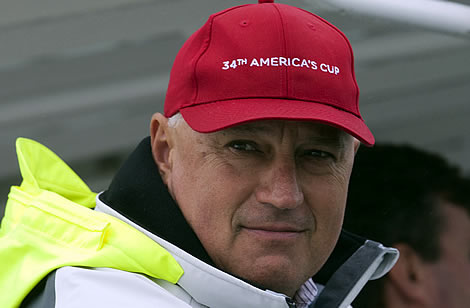
Iain Murray, Regatta Director for the 34th America’s Cup and CEO, America’s Cup Race Management, acknowledges with the revised schedule, requiring an entry fee of $100,000 payable on 1 August this year, followed by another of $200,000 on 1 June 2012, representing the entry fee to the AC72 events (ie the challenger selection series) there is a much greater possibility of late entries being accepted to the event. “To be honest I think we are will lose a couple and get a couple,” he says.
So the line-up presented in San Francisco is more accurately the teams we will see in this year’s America’s Cup World Series and specifically those who have contracted to buy AC45s. This obviously represents a substantially greater financial commitment than the entry fees as the AC45 itself costs in the region of 695,000 Euros, but on top of that there is the handling gear, sails, containers, plus a tent, etc. Murray reckons just with these items the price tag is closer to 1 million Euros.
AC45 rule and developments
The AC45 is obviously a one design and the rule for the class has now been published including a crew weight limit of 437.5kg, which is five times the 87.5kg crew weight for the AC72 rule. About the only area of variation between the boats is in their headsails of which per regatta they are allowed to measure in just four – two jibs, a genniker and a Code 0, but are only allowed to go sailing with two at a time, teams presumably having to make the call on the wind strength for the day.
“There has been a lot of different shapes and sizes, particularly in the jibs,” says Murray of the sail development he’s seen – although he admits he has still yet to get out on an AC45. “The jibs vary a lot in size. The trend has been for the jibs to get smaller and smaller and smaller. We started in New Zealand with jibs filling up the whole foretriangle, but I haven’t seen one of them for a while. It seems in many ways, that the wing is so efficient that putting up something in front of it is almost drag, but the jib certainly helps them tack.”
So jibs are becoming more like staysails. “I’m sure if it is very light breeze you’ll see full-sized headsails again, but it is a bit like then we started with the IACC yachts, they all started out looking like maxis and then in the end they looked like 12 metres...”
Murray says they are trying to avoid variation between the AC45s outside of this. “There has been some design development along the way as they learn how to sail them. We have changed winch sizes on the traveller. There has been quite a lot of things about the short sheet and how they physically get from trimming the jib to the spinnaker and bits and pieces like that. For the most part they are going to be the boats are one design.”
How late can you push it?
Looking towards the Cup itself, with all of the AC World Series events now set to be contested in AC45s all the way through into 2013, a team’s AC72 doesn’t have to be on the water in San Francisco until just before the start of the Challenger Selection Series on 13 July. Thus, in theory, a truly 11th hour campaign doesn’t need to start building until the summer of 2012. Obviously this is the least ideal situation as with this radical new genre of boat a team putting the hours in afloat to get their new beast reliable and then competitive will be of the utmost importance.
A team that seems to be taking time on the water most seriously is surprisingly China Team, who’s AC72 we understand is set to be the first to launch and could be up and running as early as April-May 2012. The Protocol for the 34th AC states that competitors can’t launch their first AC72 until 1 July 2012 from which time they are only allowed to sail the boat for 30 days over the next seven months (the first ‘sailing period’) – which is not much considering how new and extreme these boats are and how much work-up time they are certain to need. However this small period of time will help level the playing field, although one can envisage teams leaving the dock at 00:01 and returning at 23:59 in order to maximise their time afloat. Teams like China Team, which are set to launch their first AC72 prior to 1 July next year, under a new dispensation in the Protocol are permitted to sail 15 of their 30 days from the first sailing period in their home territorial waters, if granted consent by the Regatta Director.
Under the Protocol teams may not launch their second AC72 before 1 February 2013. During the second ‘sailing period’ from 1 February until 1 May 2013 teams can sail for a maximum of 45 days “per AC72 yacht”. Thus a two boat team can in theory get in twice the amount of training/development over this period than a one boat team. From 1 May 2013 on, there are no further restrictions on sailing.
While the Protocol talks of first and second boats, in reality of more relevance with the AC72s is development of their solid wingsails of which the Protocol allows teams to build ‘six sections’ ie three wings.
In terms of official racing at present the first time the AC72s will race will be in the Louis Vuitton challenger selection series, although one imagines the temptation to lay on some fleet racing for the AC72s prior to then will be great. Iain Murray reckons that informal races between the AC72s is likely to take place between team on San Francisco Bay from July next year.
ACRM AC72
One of the numerous new features of this America’s Cup is that ACRM have set up their own design and R&D team (including for example VPLP who working on the design of Oracle’s USA17 tri) to carry out studies into an AC72, the data from which can be bought by new teams. According to Murray they have had several takers for this, although he won't specify who.
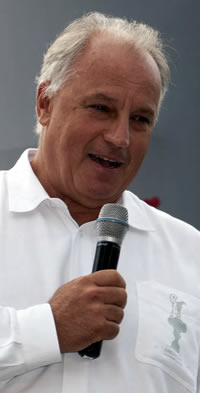 “I think it is a very worthwhile project for a number of reasons. One, we have been at it for nine months now. You assemble a big team of 20+ people and put them to work for nine months and that is the sort of time you need to do research to do a 72 design properly. For some of these teams that are just getting it together now, you can’t get that nine months back. That has always been a problem with the America’s Cup and many sporting endeavours – it doesn’t matter how much money you’ve got, you can’t get the time back. So we are very happy. The team that has been working on it has been great. We expect good things. It has been a radical enough departure to do what we’ve done. It has certainly provided a good alternative for these people as a very good starting point at a very competitive price.”
“I think it is a very worthwhile project for a number of reasons. One, we have been at it for nine months now. You assemble a big team of 20+ people and put them to work for nine months and that is the sort of time you need to do research to do a 72 design properly. For some of these teams that are just getting it together now, you can’t get that nine months back. That has always been a problem with the America’s Cup and many sporting endeavours – it doesn’t matter how much money you’ve got, you can’t get the time back. So we are very happy. The team that has been working on it has been great. We expect good things. It has been a radical enough departure to do what we’ve done. It has certainly provided a good alternative for these people as a very good starting point at a very competitive price.”
So a team buys the ACRM package and takes it where they want to from there. As Murray points out the real development is likely to be in the second and third wingsails and extra foils and soft sails.
Given that hull development is likely to be a very much smaller part of the speed equation than it has been in previous Cup boats, one wonders if they couldn’t have built a set of female hull moulds that the smaller teams could ship around to their respective countries to build their hulls from. “It probably would have been smart to have done that and there could have been quite substantial cost savings even if there had been a centralised structure for the boats, and people put their own hulls on that. But we missed that boat,” says Murray.
San Francisco Bay - home of the AC72
Murray is relieved that the AC World Series is now only being held in the AC45s and not the 72s. “I am very happy with what’s happened, because the logistics of the AC72s with every one of them being different and packing them up and moving them - it would have been quite difficult,” says Murray, the master of understatement. “And it [would] put a huge amount of pressure on the World Series sites - the space requirements for a AC72 operation is massive by comparison, there’s everything from the maintenance to the sail loft, the crane sizes, the load bearing bases for the cranes, just everything is exponentially bigger.”
The AC World Series only being sailed in AC45 has also had a big effect on how teams set up their bases. While the original plan was for teams to have no fixed abode other than in their own country and to follow the AC World Series around the globe, in which the same way as F1 does, with the AC72 sailing and racing set to be confined to San Francisco Bay, there is now much more incentive for teams to set up shop there.
“There is quite an attractive proposition to come here and the sailing so good and so regular and so consistent here and if you can do it a year beforehand there is probably a substantial advantage,” says Murray.
So it seems that the dock area in San Francisco could well turn into a mini-Valencia, although Murray says that they are planning on having much more in the way of shared facilities. This is all set to be revealed in the ‘master plan’ document for San Francisco due to go public within the next week, although it sounds as if it is not one you would want to go through in any great detail as according to Murray it is more than 2,000 pages long...
Coming to Europe
In the immediate future, the Oracle Racing AC45s are busy jousting on San Francisco Bay, while all ten AC45s are ultimately bound for Lisbon (and Valencia as was originally planned). The first AC45 World Series event is to be held in Cascais over 6-14 August, and the AC45s are likely to be into the marina at Cascais around 21-22 July. However teams that want to sail them before that will be doing so out of Lisbon.
“We have our mobilising yard in Lisbon and we are staffed up and building a temporary sailing base for the teams that come early until we can get into the marina,” says Murray. This will be in the same place as the Volvo Ocean Race will be moored.
With eight challengers and Oracle Racing fielding two boats in the AC World Series, there is now no spare boat, although Murray’s ACRM team and the teams themselves have been getting in good practice fixing them overnight.
“The main structure of the spar is very strong and it is all the elements, which is all very light and the plastic which gets damaged, but structurally they are quite strong,” when we enquire over the extent of the damage following capsizes. “I think in most cases, these boats once they have righted could have gone round and completed the race, with the exception of the very first time when the Artemis guys put the boat over. If they are righted quickly and you can keep the water out of the rig, there won’t be too much damage. Russell’s boat [which capsized last week] hit the water pretty hard and he sailed home quite okay. They were sailing the next morning, but it was a long night. With these boats, I think you sail them you get quite comfortable in them and then all of a sudden, there are certain things you can and can’t do. They do require full concentration all the time.”
Points
The exact format for the AC World regattas is still being finalised and according to Murray the intention is still for each event to span eight days, starting and finishing on a weekend. The final format is to be published soon, but the first weekend seems set to be primarily fleet racing, and this probably won’t count in the scoring for the overall regatta. On the Saturday afternoon Murray says they will be having “a bit of fun” so this probably means some exhibition racing, speed trials, unusual courses, etc. On the Monday and Tuesday will be left to the teams to do their own thing with racing starting properly on the Wednesday.
The published scoring system indicates that on Wednesday to Friday the daily format will be three 20 minute long fleet races, the points from which will then determine the final three match races of the day, for boats five and six, three and four and one and two. The culmulative points from these three days will then form the seeding for the final Saturday which will be solely match racing for the top six.
The ‘quarter final’ will see boats three and six competing in race one and boats four and five in race two. In the semis the winner of race one will go up against the second seed while the winner of race two sails the first seed. The winners of the two semi final races then go through to the finals as normal where they will sail a best of three. All races will be 20 minutes long. The final Sunday will see more fleet racing.
So will the AC World Series result have any bearing on the challenger selection series as it did in a minor way for the 32nd America’s Cup? “I don’t think it will,” says Murray. “It is something the teams could influence, but they are such different things now. We are completely different boat and different style of racing almost.”
Getting a little theoretical...if Oracle Racing successfully defend the 34th America’s Cup and the solid wingsail catamaran jamboree continues for the 35th, then there is the possibility of the America’s Cup having two parallel circuits for the AC45s and for the 72s, the former being an attractive way for a new team to get into the competition. “I think that is probably right,” says Murray. “The teams that can campaign a 45 as opposed to a 72 is a huge number. But it is going to be venue dependent.”
One wonders in fact if a solid wingsail 72ft catamaran, while certain to be a thoroughly awe-inspiring piece of sailing kit, isn’t actually too big/fast for San Francisco Bay or to achieve the tight/short course spectator/TV-friendly racing Russell Coutts envisages for the America’s Cup competition. “The 45s on the Bay here are impressive in their own right, let alone a boat that has double the height of rig and triple the sail area,” says Murray. “The 45s have been plenty imposing on the Bay. San Francisco Bay is a big place, it is 7 miles across and they eat it up alright.”
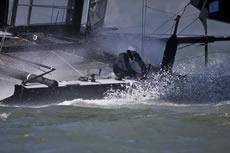 |
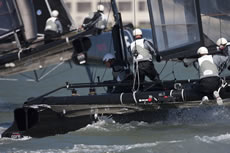 |
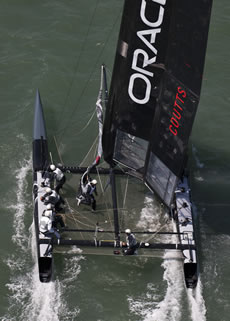 |
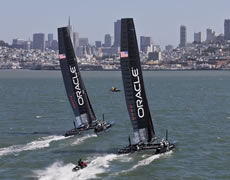 |
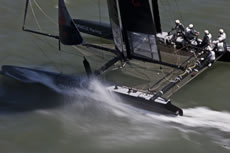 |
|
And let us not forget the famous Coutts capsize...!
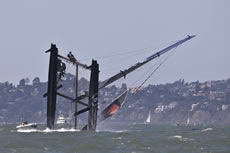 |
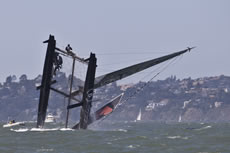 |
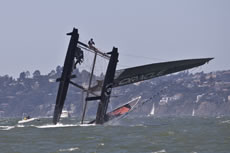 |
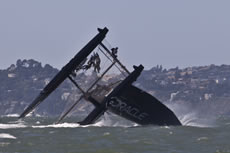 |
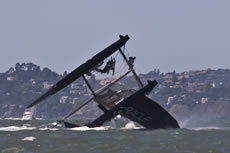 |
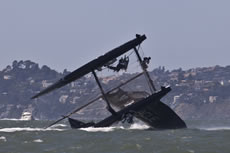 |
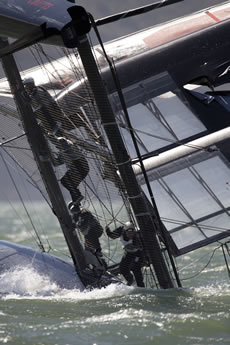 |
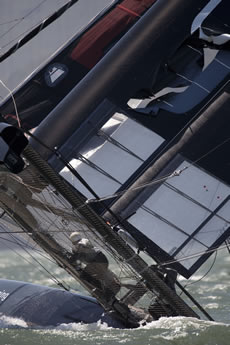 |
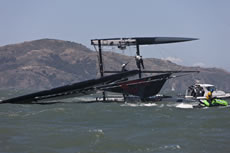 |
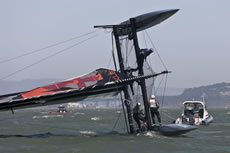 |
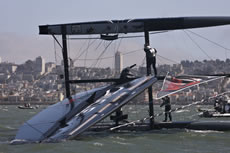 |

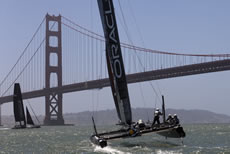







Latest Comments
Add a comment - Members log in